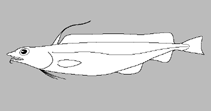Gadella svetovidovi Trunov, 1992
Ajouter votre observation dans Fish WatcherAquaMaps webservice down at the moment
Envoyez vos Photos et vidéos
Images GoogleNo image available for this species;
drawing shows typical species in Moridae.
Images GoogleNo image available for this species;
drawing shows typical species in Moridae.
Classification / Names Noms communs | Synonymes | Catalog of Fishes(Genre, Espèce) | ITIS | CoL | WoRMS | Cloffa
> Gadiformes (Cods) > Moridae (Morid cods)
Etymology: Gadella: Diminutive of latin, gadus = a fish, cod? (Ref. 45335); svetovidovi: Named in honor of Anatoliy Nikolaevich Svetovidov (1903-1985) for his great contributions to the study of gadoid fishes (Ref. 44938).
Eponymy: Anatolii Nikolaveich Svetovidov (1903–1985) was a Russian ichthyologist. [...] (Ref. 128868), visit book page.
Etymology: Gadella: Diminutive of latin, gadus = a fish, cod? (Ref. 45335); svetovidovi: Named in honor of Anatoliy Nikolaevich Svetovidov (1903-1985) for his great contributions to the study of gadoid fishes (Ref. 44938).
Eponymy: Anatolii Nikolaveich Svetovidov (1903–1985) was a Russian ichthyologist. [...] (Ref. 128868), visit book page.
Environment: milieu / climate zone / depth range / distribution range Écologie
marin bathydémersal; profondeur 230 - 735 m (Ref. 44938). Deep-water; 24°S - 31°S
Distribution Pays | Zones FAO | Écosystèmes | Occurrences | Point map | Introductions | Faunafri
Southeast Atlantic: known from its type locality, Walvis Ridge.
Taille / Poids / Âge
Description synthétique Clés d'identification | Morphologie | Morphométrie
Épines dorsales (Total) : 0; Rayons mous dorsaux (Total) : 73 - 79; Épines anales: 0; Rayons mous anaux: 68 - 73. Some teeth in upper jaw moderately large; teeth in lower jaw very large; 63-73 rays in second dorsal fin. Gill rakers very short, pear-shaped. Pelvic fins shore, often reaching base of the anal fin. Abdominal cavity extends to below the base of the 23rd-24th ray of the anal fin. Interbranchial membrane lacks scales. 54 vertebrae (without urostyle). Caudal fin weakly rounded (Ref. 44938).
Life cycle and mating behavior Maturité | Reproduction | Frai | Œufs | Fécondité | Larves
Référence principale
Upload your references | Références | Coordinateur | Collaborateurs
Trunov, I.A., 1992. Fish of the family Moridae from the southeastern Atlantic (Genera Gadella , Halargyreus, and Antimora). J. Ichthyol. 32(4):38-45. (Ref. 44938)
Statut dans la liste rouge de l'IUCN (Ref. 130435: Version 2024-2)
Données manquantes (DD) ; Date assessed: 02 February 2015
CITES
Not Evaluated
Menace pour l'homme
Harmless
Utilisations par l'homme
FAO - Publication: search | FishSource |
Plus d'informations
Trophic ecology
Éléments du régime alimentaire
Composition du régime alimentaire
Consommation alimentaire
Food rations
Prédateurs
Éléments du régime alimentaire
Composition du régime alimentaire
Consommation alimentaire
Food rations
Prédateurs
Ecology
Écologie
Écologie
Population dynamics
Paramètres de croissance
Max. ages / sizes
Length-weight rel.
Length-length rel.
Fréquences de longueurs
Mass conversion
Recrutement
Abondance
Paramètres de croissance
Max. ages / sizes
Length-weight rel.
Length-length rel.
Fréquences de longueurs
Mass conversion
Recrutement
Abondance
Life cycle
Reproduction
Maturité
Maturity/Gills rel.
Fécondité
Frai
Spawning aggregations
Œufs
Développement de l'œuf
Larves
Dynamique des populations larvaires
Reproduction
Maturité
Maturity/Gills rel.
Fécondité
Frai
Spawning aggregations
Œufs
Développement de l'œuf
Larves
Dynamique des populations larvaires
Anatomy
Surface branchiale
Brain
Otolith
Surface branchiale
Brain
Otolith
Physiology
Body composition
Nutrients
Consommation d'oxygène
Type de nage
Vitesse de nage
Visual pigments
Fish sound
Diseases & Parasites
Toxicity (LC50s)
Body composition
Nutrients
Consommation d'oxygène
Type de nage
Vitesse de nage
Visual pigments
Fish sound
Diseases & Parasites
Toxicity (LC50s)
Genetics
Génétique
Heterozygosity
Héritabilité
Génétique
Heterozygosity
Héritabilité
Human related
Aquaculture systems
Profils d'aquaculture
Souches
Ciguatera cases
Stamps, coins, misc.
Aquaculture systems
Profils d'aquaculture
Souches
Ciguatera cases
Stamps, coins, misc.
Outils
E-book | Guide de terrain | Générateur de fréquences de longueur | Outil de dynamique de population | Carte par point | Classification Tree
| Catch-MSY |
Articles particuliers
Télécharger en XML
Sources Internet
AFORO (otoliths) | Aquatic Commons | BHL | Cloffa | BOLDSystems | Websites from users | FishWatcher | CISTI | Catalog of Fishes: Genre, Espèce | DiscoverLife | ECOTOX | FAO - Publication: search | Faunafri | Fishipedia | Fishtrace | GenBank: génôme, nucléotide | GloBI | Google Books | Google Scholar | Google | IGFA World Record | MitoFish | Otolith Atlas of Taiwan Fishes | PubMed | Reef Life Survey | Socotra Atlas | Arbre de Vie | Wikipedia: aller à, chercher | World Records Freshwater Fishing | Zoobank | Zoological Record
Estimates based on models
Phylogenetic diversity index (Ref. 82804): PD50 = 0.5001 [Uniqueness, from 0.5 = low to 2.0 = high].
Bayesian length-weight: a=0.00389 (0.00192 - 0.00787), b=3.11 (2.93 - 3.29), in cm total length, based on LWR estimates for this (Sub)family-body shape (Ref. 93245).
Niveau trophique (Ref. 69278): 3.3 ±0.3 se; based on size and trophs of closest relatives
Résilience (Ref. 120179): Milieu, temps minimum de doublement de population : 1,4 à 4,4 années (Assuming tmax>3).
Fishing Vulnerability (Ref. 59153): Low vulnerability (24 of 100).




